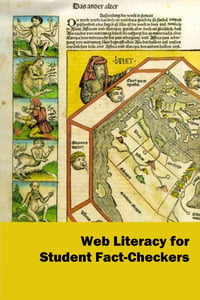 If you’re looking for creative ways to prep for your upcoming library instruction, consider checking out Web Literacy for Student Fact-Checkers (2018) by Mike Caulfield, director of blended and networked learning at Washington State University Vancouver and head of the Digital Polarization Initiative of the American Democracy Project. From fact-checking Wikipedia, to finding original sources of a viral social media post, to identifying owners/creators of websites, this open access publication makes for a great starting point when teaching research techniques.
If you’re looking for creative ways to prep for your upcoming library instruction, consider checking out Web Literacy for Student Fact-Checkers (2018) by Mike Caulfield, director of blended and networked learning at Washington State University Vancouver and head of the Digital Polarization Initiative of the American Democracy Project. From fact-checking Wikipedia, to finding original sources of a viral social media post, to identifying owners/creators of websites, this open access publication makes for a great starting point when teaching research techniques.
Whether consuming media or conducting research, today’s college students are faced with an incredible wealth of information. This “practical guide for the student fact-checker” (p. 3) contains several strategies, exercises, and activities to help students understand veracity and the importance of fact-checking, and teach them how to be “web-literate.”
Here are some suggestions for using this instructional manual:
- Teaching a course-integrated workshop: There is often tension between faculty members’ desire for students to only use library databases and cite peer-reviewed articles and students’ inclination towards Google. Caulfield recommends using Google Scholar to check authors’ expertise by examining their publication history. This can be helpful for students to think about academic sources and the scholars who work on them. If there are cited researchers in the news, this is where you can have students verify their publication record to see if they can be considered an “expert.” This activity encourages students to question what they read and analyze the research evidence and claims presented (or lacking) in front of them.
- Ice-breakers that encourage students to critically evaluate online information: Similar to the CRAAP Test, Caulfield provides a list of websites and asks students to “answer the following questions to determine the reputability of each site: Who runs them? To what purpose? What is their history of accuracy, and how do they rate on process, aim, and expertise?” (p 91). This activity can be helpful to show students how to identify and evaluate bias in online information. Have students compare the content they find in these websites with other similar content found online or in library databases to show how credible or incredible online information can be.
- Increase student engagement through gamification and group activities: Organize students to work in teams as they learn about different veracity techniques and apply them into a research game. Have the groups complete tasks like identifying fake image vs. real image, citing a viral social media post, and/or fact-checking specific quotes and events. After giving time for students to complete these short exercises, reveal the correct answers and show them how to verify images, texts, and content they often encounter online.
Tip: The key in maximizing the impact of any activity is to solicit feedback and reflections from students so that they can think through what they have learned and experienced.
Caulfield provides a wide variety of activities throughout the book, which can be adapted into specific in-person classes or online modules. You might even consider collaborating with a professor to co-teach these research skills in an open forum to the general public in the academic library or at the local public library.
Web Literacy for Student Fact-Checkers is definitely worth exploring, particularly for those librarians who often teach information literacy workshops in first year writing, communication/media studies, and journalism courses.

/CTA%20Images/1st_YearExperience_Call-to-Action-1.jpg?width=600&name=1st_YearExperience_Call-to-Action-1.jpg)